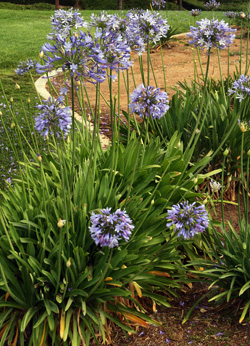Releasing the Secret to Successful Agapanthus Growing: Advice for a Flourishing Garden
In the realm of horticulture, growing agapanthus efficiently calls for a critical strategy that incorporates numerous elements of plant care. By comprehending the nuances of agapanthus farming, one can create a setting where these plants flourish and grow generously.
Planting Agapanthus: Ideal Practices
When planting Agapanthus, appropriate soil preparation is necessary for ensuring effective development and advancement of these lovely flowers. Agapanthus, typically known as Lily of the Nile or African lily, flourishes in well-draining dirt with a somewhat acidic to neutral pH level - Agapanthus. Before growing, it is crucial to change hefty clay dirts with raw material such as garden compost or peat moss to boost drain and supply vital nutrients for the plants
To grow Agapanthus, pick an area that obtains full sunshine to partial shade, as this will certainly promote healthy and balanced development and bountiful flowering. Dig a hole two times the diameter of the plant's root ball and position the Agapanthus at the exact same deepness it was previously expanding. Delicately backfill the opening with soil, pushing down strongly to eliminate any type of air pockets around the roots.
Water the newly planted Agapanthus extensively and remain to keep the soil equally damp, especially during the plant's active expanding season. Agapanthus. Applying a well balanced fertilizer once a month can better support the plant's development and blooming. By following these best practices for planting Agapanthus, you can develop a sensational display of these exciting flowers in your yard
Ideal Dirt Conditions for Agapanthus
For optimal growth and growing success of Agapanthus plants, making certain the dirt conditions are ideal is important. Agapanthus chooses soil that is rich in nutrients, so including a balanced plant food throughout the expanding period can promote healthy growth and vibrant flowers.

Watering and Fertilizing Tips
To guarantee healthy growth and vibrant blossoms, correct watering and feeding strategies are crucial for successful Agapanthus growing. Agapanthus plants profit from routine watering, specifically during the expanding period.
When it comes to feeding Agapanthus, a well balanced fertilizer with equivalent parts nitrogen, phosphorus, and potassium can be used in the springtime to advertise healthy growth and flowering. Slow-release fertilizers are perfect for providing nutrients progressively over an extended period. Avoid over-fertilizing, as this can bring about too much foliage development at the expense of blossoms.
Furthermore, incorporating natural matter like garden compost into the dirt can enhance nutrient degrees and enhance dirt framework, aiding in the total health and wellness of the Agapanthus plants. By following these watering and feeding suggestions, garden enthusiasts can guarantee their Agapanthus plants grow and produce spectacular displays of flowers.
Pruning and Deadheading Methods
Correct trimming and deadheading methods play an important duty in preserving the health and wellness and aesthetic appeals of Agapanthus plants, complementing the necessary practices of watering and feeding for effective cultivation. Pruning Agapanthus includes eliminating invested flower heads, dead or yellowing fallen leaves, and overall shaping of the plant to advertise much better growth. Deadheading, the process of getting rid of faded flowers, not just enhances the plant's look but also motivates additional blooming.
When deadheading Agapanthus, it is a good idea to trim off the flower stem at the base utilizing sharp, clean shears. This process redirects the plant's energy from seed manufacturing back right into root and foliage growth, promoting a much healthier and much more robust plant. Routine deadheading can expand the growing period of Agapanthus and stop self-seeding, which can bring about congestion.
In terms of pruning, Agapanthus normally take advantage of a light trim after flowering to clean up the plant and urge fresh development. Cutting back the invested flower stems and removing any broken or dead vegetation assists preserve the plant's vitality and total appearance. Nonetheless, it is vital to avoid cutting into the crown of the plant, as this can weaken its health.

Protecting Agapanthus From Vermins and Diseases
Applying reliable parasite and disease administration techniques is essential to safeguarding the wellness and vitality important site of Agapanthus plants in growing. One common parasite that affects Agapanthus is the Agapanthus borer, a caterpillar that passages right into the plant, creating damage to the leaves and flowers.
In addition to bugs, Agapanthus are at risk to illness such as origin rot and fungal fallen leave areas. These concerns can often be avoided by making certain proper water drainage and preventing overwatering. Affected components of the plant should be immediately removed to stop more spread if signs of illness appear. Fungicides may also be used as a treatment step, complying with the producer's instructions carefully. By remaining watchful and resolving bug and illness concerns quickly, garden enthusiasts can assist their Agapanthus flourish and prosper.

Final Thought
To conclude, effective farming of agapanthus requires correct planting methods, suitable soil conditions, appropriate watering click and feeding, routine trimming and deadheading, and defense from diseases and parasites. By complying with these suggestions and techniques, garden enthusiasts can make certain a prospering yard full of stunning agapanthus flowers. Agapanthus. Keep in mind to keep regular treatment and interest to information to advertise the health and durability of these stunning plants
When planting Agapanthus, proper soil prep work is necessary for making certain successful development and advancement of these gorgeous flowers.Water the freshly grown Agapanthus extensively and proceed to keep the dirt equally wet, specifically throughout the plant's active growing season.For optimum growth and flowering success of Agapanthus plants, making sure the soil conditions are ideal is vital. When transplanting or growing Agapanthus, make certain the dirt is well-prepared to offer the required foundation for More Bonuses the plants to establish themselves effectively. One typical parasite that affects Agapanthus is the Agapanthus borer, a caterpillar that passages into the plant, triggering damage to the flowers and fallen leaves.
Comments on “Typical Agapanthus Issues and How to Address Them”